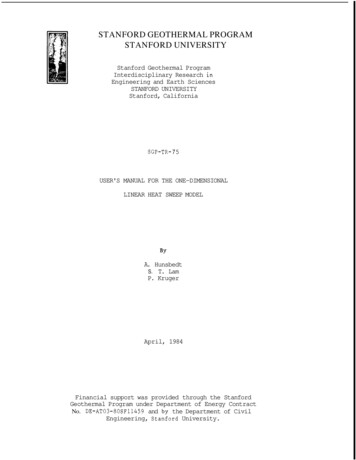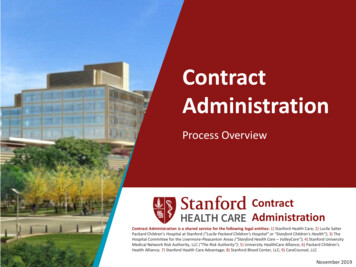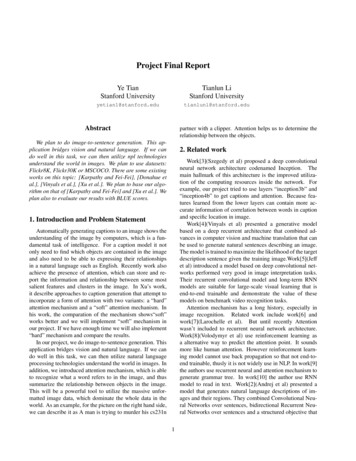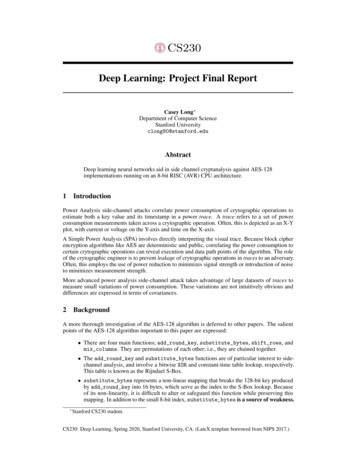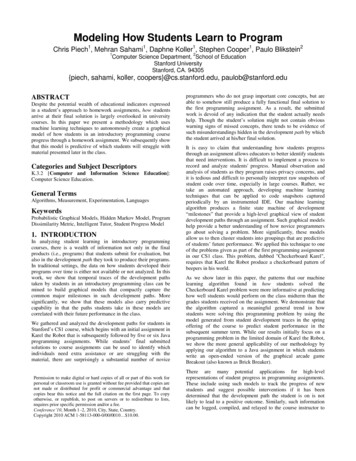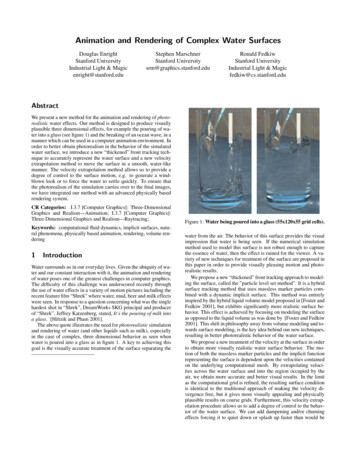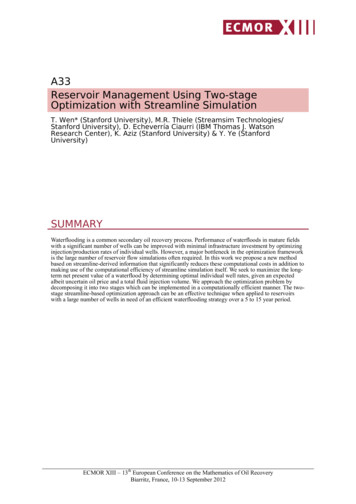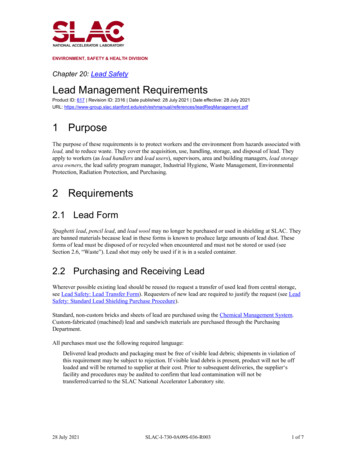
Transcription
ENVIRONMENT, SAFETY & HEALTH DIVISIONChapter 20: Lead SafetyLead Management RequirementsProduct ID: 617 Revision ID: 2316 Date published: 28 July 2021 Date effective: 28 July 2021URL: references/leadReqManagement.pdf1 PurposeThe purpose of these requirements is to protect workers and the environment from hazards associated withlead, and to reduce waste. They cover the acquisition, use, handling, storage, and disposal of lead. Theyapply to workers (as lead handlers and lead users), supervisors, area and building managers, lead storagearea owners, the lead safety program manager, Industrial Hygiene, Waste Management, EnvironmentalProtection, Radiation Protection, and Purchasing.2 Requirements2.1 Lead FormSpaghetti lead, pencil lead, and lead wool may no longer be purchased or used in shielding at SLAC. Theyare banned materials because lead in these forms is known to produce large amounts of lead dust. Theseforms of lead must be disposed of or recycled when encountered and must not be stored or used (seeSection 2.6, “Waste”). Lead shot may only be used if it is in a sealed container.2.2 Purchasing and Receiving LeadWherever possible existing lead should be reused (to request a transfer of used lead from central storage,see Lead Safety: Lead Transfer Form). Requesters of new lead are required to justify the request (see LeadSafety: Standard Lead Shielding Purchase Procedure).Standard, non-custom bricks and sheets of lead are purchased using the Chemical Management System.Custom-fabricated (machined) lead and sandwich materials are purchased through the PurchasingDepartment.All purchases must use the following required language:Delivered lead products and packaging must be free of visible lead debris; shipments in violation ofthis requirement may be subject to rejection. If visible lead debris is present, product will not be offloaded and will be returned to supplier at their cost. Prior to subsequent deliveries, the supplier‘sfacility and procedures may be audited to confirm that lead contamination will not betransferred/carried to the SLAC National Accelerator Laboratory site.28 July 2021SLAC-I-730-0A09S-036-R0031 of 7
SLAC National Accelerator LaboratoryEnvironment, Safety & Health DivisionLead Safety Lead Management RequirementsThe requesting SLAC organization will be responsible for receiving lead shipments and inspecting forvisible lead debris (including machined shavings and loose chips). If such contamination is present, the leadsafety program manager will be notified and the shipment will not be accepted.2.3 Lead Storage and ManagementAll lead at SLAC must be stored indoors in designated areas, with proper signage and controls. Lead inunusable forms will be properly stored until recycled or disposed of.Equipment containing lead should also be stored indoors and may only be stored outdoors by exception andonly with the approval of the lead safety program manager. For any such exceptions the lead safetyprogram manager will determine appropriate covering, signage, and periodic inspection requirements.The lead safety program manager will consult with Environmental Protection concerning outdoor storageexceptions.2.3.1HousekeepingSurfaces will be maintained as free as practicable from accumulation of lead as required by the Cal/OSHAlead standard (8 CCR 5198 [h][1]).Proper cleaning methods must be used where lead dust may be present in order to prevent personalexposures or environmental contamination (see Lead Safety: Lead Work Requirements).2.3.2Lead Storage AreasThe storage area owner must ensure that lead storage areas are inspected periodically (not less than onceper year), cleaned as necessary, and posted with the signs identifying both the hazard and the prohibitedactivities.Figure 1 Lead Storage Area Warning SignAt the request of the lead safety program manager, Industrial Hygiene will conduct lead surface dustsampling to test for the presence of lead dust in storage areas when appropriate.28 July 2021SLAC-I-730-0A09S-036-R0032 of 7
SLAC National Accelerator LaboratoryEnvironment, Safety & Health DivisionLead Safety Lead Management Requirements2.3.3Lead Use Areas2.3.3.1Shielding in PlaceIn accelerator or experimental areas where unpainted lead shielding is present, the area must be inspectedperiodically (not less than once per year) and cleaned as necessary. In accelerator or experimental areaswhere painted lead shielding is present, the area should be inspected periodically and cleaned or repaintedas necessary.When accelerator or experimental area lead shielding is moved, the area should be inspected and cleaned.At the request of the lead safety program manager, Industrial Hygiene will conduct lead surface dustsampling to test for the presence of lead dust in accelerator or experimental areas when appropriate.2.3.3.2Detector LeadThe lead safety program manager is responsible for inspecting and determining the need for cleaning ofdetector surfaces at the Stanford Large Detector (SLD) and the Mark II Detector in the Building 750 pit,and the High Resolution Spectrometer (HRS) in Building 660.2.3.3.3Machining and CuttingLead use areas where lead machining or cutting is performed will be cleaned and inspected at the end ofeach job or project.Lead will be machined in the following locations exclusively. The exception to this, by approval of the leadsafety program manager, is for equipment, shielding, or other lead materials that cannot be moved in apracticable way to a listed machining location. Safe lead work practices must be used and a 6 millimeterthick polyethylene sheet must be used to contain all lead shavings. Lead machining areas will be cleanedand inspected at the end of each job or project (see Lead Safety: Lead Work Requirements).Table 1 Lead Machining and Cutting LocationsLocationKlystron High Bay (Building 044)SSRL lead machining tent with air cleaner (Building 131)MFD machine shops (Buildings 025 and 26)2.3.3.4PostingWhere lead work may result in exposures that may reach half of the permissible exposure level (PEL), thesupervisor is required to ensure the area is posted with signs identifying both the hazard and the prohibitedactivities.28 July 2021SLAC-I-730-0A09S-036-R0033 of 7
SLAC National Accelerator LaboratoryEnvironment, Safety & Health DivisionLead Safety Lead Management RequirementsFigure 2 Lead Work Area Warning Sign2.4 Movement and Transportation of Lead and Items withLead2.4.1.1Lead Movement within Lead Use AreasLead must be moved in a manner that minimizes the potential for occupational exposure and environmentalcontamination. Any lead wool or loose lead debris associated with shielding must be separated forrecycling or disposal.2.4.1.2Lead Movement between Use Areas or BuildingsWhile being moved from one area to another, lead must be protected from contact with rain and wrappedwith plastic or similarly contained to prevent release of lead into the environment. The lead safety programmanager must be notified of the move and the quantities and location.2.4.1.3Movement of Items / Equipment with LeadSLAC has experimental equipment with lead shielded components and shielding (for example, concreteblocks and klystrons) and materials that may have residual lead on their surfaces. These items must beinspected before moving. If it appears that residual lead is present, the lead safety program manager mustbe contacted, who will coordinate inspection and lead removal, if required. Equipment with leadcomponents should be wrapped or otherwise contained in a manner that prevents the release of lead duringmovement.2.4.1.4Removal of Lead ShieldingLead shielding to be reused must be transferred to Central Lead Storage, after having been surveyed by theRadiation Protection Field Operations (RPFO) (see Lead Safety: Lead Transfer Form).NoteAny removal of lead used as shielding requires a Radiation Safety Work Control Form (seeRadiological Safety: Facility Design and Operation Requirements).28 July 2021SLAC-I-730-0A09S-036-R0034 of 7
SLAC National Accelerator LaboratoryEnvironment, Safety & Health DivisionLead Safety Lead Management Requirements2.5 Radioactive Lead2.5.1Identification of Radioactive LeadRadioactive lead must be identified with a stamped trefoil symbol and yellow paint.2.5.2Handling of Radioactive LeadWorkers handling radioactive lead must have Radiological Worker I Training (ESH Course 116). Handlingincludes the use of hands or tools to move/manipulate radioactive lead.If the lead has loose radioactive contamination then Radiological Worker II Training (ESH Course 250) isrequired. Radioactive contamination information is noted on the radioactive material tag. Lead identified tohave loose radioactive contamination must be appropriately contained, such as wrapped in polyethylene.2.5.3Working with Radioactive LeadA radiological work permit (RWP) must be issued before working on radioactive lead. Work includes theuse of tools to perform actions such as cutting, machining, welding, grinding, filing, or drilling onradioactive lead. The RWP will list the radioactive controls, which may include The use of HEPA vacuums Personal protective equipment (PPE) for contamination Respirators VentilationTo obtain an RWP a procedure or RWP application must be submitted to Radiation Protection FieldOperations (RPFO) detailing the tasks to be completed (see the Radiological Work Permits Procedure forfurther information).2.5.4Storage and Management of Radioactive LeadRadioactive lead should be segregated from non-radioactive lead in order to avoid generating unnecessarymixed waste. Radioactive lead should be stored indoors as practicable (see Section 2.3, “Lead Storage andManagement”). If radioactive lead must be stored outdoors, approval from Radiation Protection is required.Excess radioactive lead should be reused on-site. If no on-site use can be identified, it must be listed in theDepartment of Energy (DOE) excess materials database to offer for reuse at other DOE sites.2.6 Waste2.6.1Radioactive WasteAll radioactive lead considered waste is regulated as a mixed waste and must be shipped off-site within 90days of generation.28 July 2021SLAC-I-730-0A09S-036-R0035 of 7
SLAC National Accelerator LaboratoryEnvironment, Safety & Health DivisionLead Safety Lead Management RequirementsThe declaration as waste must be coordinated with the Radioactive Waste Management Group to ensuredisposal within the regulatory timeframe and securing of funding appropriate for the waste generationvolume expected (see Radiological Safety: Radioactive and Nuclear Material and Waste Requirements).2.6.2Lead Waste and Lead Contaminated WasteAll wastes contaminated with lead meeting the state and federal regulatory threshold limit concentrationsare classified as hazardous waste. Disposal must be coordinated with Waste Management (see Chapter 17,“Hazardous Waste”).NoteSee Chapter 17 for disposal of lead-containing items not within the scope of this chapter, suchas lead-acid batteries, cathode ray tubes, and solder waste containers.3 FormsThe following forms are required: Lead Safety: Lead Transfer Form (SLAC-I-730-0A09J-007). Form for documenting the radiologicalstatus of lead to be transferred to or from central storage Chemical Management System. System used for ordering and tracking chemicals and storing safetydata sheets4 RecordkeepingThe following recordkeeping requirements apply for these requirements: The Central Lead Storage manager keeps the completed lead transfer forms.5 ReferencesSLAC Environment, Safety, and Health Manual (SLAC-I-720-0A29Z-001) Chapter 20, “Lead Safety”–Lead Safety: Standard Lead Shielding Purchase Procedure (SLAC-I-730-0A09C-005)–Lead Safety: Lead Work Requirements (SLAC-I-730-0A09S-001)Chapter 9, “Radiological Safety”–Radiological Safety: Facility Design and Operation Requirements (SLAC-I-760-0A05S-003)–Radiological Safety: Radioactive and Nuclear Material and Waste Requirements (SLAC-I-7600A30S-001)Chapter 17, “Hazardous Waste”Other SLAC Documents Chemical Management Services (CMS)28 July 2021SLAC-I-730-0A09S-036-R0036 of 7
SLAC National Accelerator LaboratoryEnvironment, Safety & Health DivisionLead Safety Lead Management Requirements Radiological Work Permits Procedure (SLAC-I-760-0A05C-002) ESH Course 116, Radiological Worker I Training (ESH Course 116) ESH Course 250, Radiological Worker II Training (ESH Course 250)Other Documents Title 8, California Code of Regulations, “Industrial Relations”, Division 1, “Department of IndustrialRelations”, Chapter 4, “Division of Industrial Safety”, Subchapter 7, “General Industry Safety Orders”,Group 16, “Control of Hazardous Substances”, Article 109, “Hazardous Substances and Processes”,Section 5198, “Lead” (8 CCR 5198)28 July 2021SLAC-I-730-0A09S-036-R0037 of 7
Lead will be machined in the following locations exclusively. The exception to this, by approval of the lead safety program manager, is for equipment, shielding, or other lead materials that cannot be moved in a practicable way to a listed machining location. Safe lead work practices must be used and a 6 millimeter
